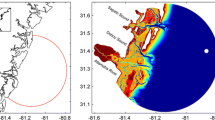Abstract
Using 1-year simulated data from extended Prince William Sound (PWS) nowcast/forecast system, both barotropic and baroclinic transports through two-strait, semi-enclosed PWS are examined. With major tidal constituents removed, hourly time series of volume transports through two straits are significantly correlated with net transport well balanced by the time rate of change of the PWS spatial-mean sea level. A transition frequency band occurs within the coherence function of hourly volume transports, which is characterized by a nearly 180° phase shift between low-frequency (>30 h) and high-frequency (<6 h) bands. The transition band is implicitly related to the horizontally divergent and horizontally non-divergent flows inside the Sound. Further investigation of monthly and annual mean volume transports indicates strong seasonal variability of flows through two straits. On the other hand, baroclinic transport through PWS demonstrates the transition between a two-layered flow structure during the wintertime and a well-defined three-layered structure, i.e., inflow in both the surface and bottom layer with outflow in the intermediate layer, in the remainder of the year. This three-layer exchange flow is determined to be mainly buoyancy-driven, geostrophic flow, and thus largely affected by seasonal variability of buoyancy over the shelf and PWS.












Similar content being viewed by others
References
Bang I, Mooers CNK (2003) The influence of several factors controlling the interactions between Prince William Sound, Alaska, and the Northern Gulf of Alaska. J Phys Oceanogr 33:19–36
Bang I, Vaughan SL, Mooers CNK (2005) Initial steps toward validation of a seasonal cycle simulation for Prince William Sound circulation (flow and mass) fields. Cont Shelf Res 25:901–934
Barron CN, Kara AB, Martin PJ, Rhodes RC, Smedstad LF (2006) Formulation, implementation and examination of vertical coordinate choices in the Global Navy Coastal Ocean Model (NCOM). Ocean Model 11(3–4):347–375
Blumberg AF, Mellor GL (1987) A description of a three-dimensional coastal ocean circulation model. In: Heaps NS (ed) Coastal and estuarine science 4: three-dimensional coastal ocean models, vol 18. American Geophysical Union, Washington, DC, pp 1–16
Candela J (1991) The Gilbraltar Strait and its role in the dynamics of the Mediterranean Sea. Dyn Atmos Ocean 15:267–300
Cox W (2004) The Prince William Sound 2004 Lagrangian field experiment. Technical report. Oil Spill Recovery Institute (OSRI), Cordova
Deleersnijder E, Wang J, Mooers CNK (1998) A two-compartment model for understanding the simulated three-dimensional circulation in Prince William Sound, Alaska. Cont Shelf Res 18:279–287
Denton RA (1990) Classification of unidirectional three-layer flow over a bump. J Hydraul Res 28:215223
Gill AE (1982) Atmosphere–ocean dynamics. Academic, San Diego
Helfrich KR (1995) Time-dependent two-layer hydraulic exchange flows. J Phys Oceanogr 25:359–373
Liu H, Olsson PQ, Volz KP, Yi H (2006) A climatology of mesoscale model simulated low-level wind jets over Cook Inlet and Shelikof Strait, Alaska. Estuar Coast Shelf Sci 70:551–566
Mellor GL (2002) User’s guide for a three-dimensional, primitive equation, numerical ocean model. Princeton University, Princeton, 41 pp
Mooers CNK, Wu X, Bang I (2009) Performance of a nowcast/forecast system for Prince William Sound, Alaska. Cont Shelf Res 29:42–60. doi:10.1016/j.csr.2007.09.008
Muench RD, Heggie DT (1978) Deepwater exchange in Alaskan subarctic fjords, in estuarine transport processes, edited by B. Kjerfve. Belle W Baruch Libr Mar Sci 7:239–267
Niebauer HJ, Royer TC, Weingartner TJ (1994) Circulation of Prince William Sound, Alaska. J Geophys Res 99:14113–14126
Pawlowicz R, Beardsley B, Lentz S (2002) Classical tidal harmonic analysis including error estimates in MATLAB using T_TIDE. Comput Geosci 28:929–937
Pielke RA, Cotton WR, Walko RL, Tremback CJ, Lyons WA, Grasso LD, Nicholls ME, Moran MD, Wesley DA, Lee TJ, Copeland JH (1992) A comprehensive meteorological modeling system—RAMS. Meteorol Atmos Phys 49:69–91
Royer TC (1975) Seasonal variations of waters in the Northern Gulf of Alaska. Deep-Sea Res 22:403–416
Royer TC, Hansen DV, Pashinski DJ (1979) Coastal flow in the Northern Gulf of Alaska as observed by dynamic topography and satellite tracked drogued drift buoys. J Phys Oceanogr 9:785–801
Schmidt GM (1977) The exchange of water between Prince William Sound the Gulf of Alaska. Master’s thesis, University of Alaska, Fairbanks, 116 pp
Smeed DA (2000) Hydraulic control of three-layer exchange flows: application to the Bab al Mandab. J Phys Oceanogr 30:2574–2588
Sofianos S (2000) Circulation and water mass formation in the Red Sea, and the exchange with the Indian Ocean. PhD dissertation, University of Miami
Spall MA, Holland WR (1991) A nested primitive equation model for oceanic applications. J Phys Oceanogr 21:205–220
Toulany B, Garrett C (1984) Geostrophic control of fluctuating barotropic flow through straits. J Phys Oceanogr 14:649–655
Vaughan SL, Mooers CNK, Gay SM III (2001) Physical variability in Prince William Sound during the SEA study (1994–98). Fish Oceanogr 10(Suppl 1):58–80
Wang J, Jin M, Patrick EV, Allen JR, Eslinger DL, Mooers CNK, Cooney RT (2001) Numerical simulations of the seasonal circulation patterns and thermohaline structures of Prince William Sound, Alaska. Fish Oceanogr 10(Suppl 1):132–148
Williams WJ, Weingartner TJ, Hermann AJ (2007) Idealized three-dimensional modeling of seasonal variation in the Alaska Coastal Current. J Geophys Res 112:C07001. doi:10.1029/2005JC003285
Wu X (2008) Response of a small, two-strait semi-enclosed sea to external forcings. PhD dissertation, University of Miami, 240 pp
Acknowledgements
The author thanks for the funding support from Oil Spill Recovery Institute (OSRI, Alaska) and appreciates the help and suggestion from Prof. Christopher N.K. Mooers. Comments from two anonymous reviewers greatly improve the work.
Author information
Authors and Affiliations
Corresponding author
Additional information
Responsible Editor: Roger Proctor
Rights and permissions
About this article
Cite this article
Wu, X. Transport through Prince William Sound: numerical study in a nowcast/forecast system. Ocean Dynamics 61, 449–462 (2011). https://doi.org/10.1007/s10236-010-0372-5
Received:
Accepted:
Published:
Issue Date:
DOI: https://doi.org/10.1007/s10236-010-0372-5



